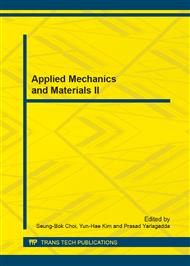p.829
p.836
p.840
p.845
p.850
p.858
p.864
p.870
p.874
Two-Dimensional Shear Stress on Bonding Interface of FRP Plate Reinforced Hydraulic Concrete
Abstract:
The bonded interface between FRP plate and the hydraulic concrete is a key part while reinforcing the hydraulic concrete structure with FRP plate. The bond property of the interface directly decides the results of structural reinforcement. In most of the external loading conditions, this interface is under the shear stress state. Therefore, accurate measurement and analysis of interfacial shear stress distribution is the guarantee of FRP reinforced hydraulic concrete structure the premise of success. Focusing on the shear-resisting bonding strength of FRP-concrete interface, this paper improved the ASTM D905 standard shear sample and carried out numerical simulation of shear test to the bonded interface of FRP-reinforced hydraulic concrete structure by adopting the bi-dimensional finite element method, and conducted parameter analysis of the influence factors (elasticity modulus of FRP and concrete, shear modulus and thickness, etc) of shear stress on the FRP-concrete bonded interface and finally the distribution characteristics of shear stress on the bonded interface were obtained. This paper mainly discussed the influence rules of stress concentration to the distribution of shear stress on the bonded interface, which provides theoretical guidance and direction to the shear-resisting bonding strength test in the next step as well as technical support to the processing of FRP-strengthened hydraulic concrete bonded interface.
Info:
Periodical:
Pages:
850-857
Citation:
Online since:
December 2013
Authors:
Keywords:
Price:
Сopyright:
© 2014 Trans Tech Publications Ltd. All Rights Reserved
Share:
Citation:


